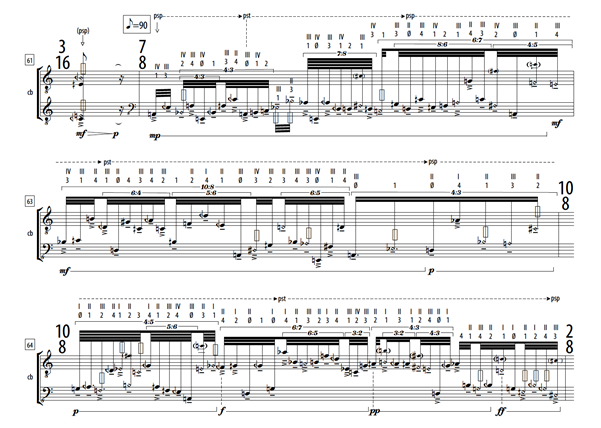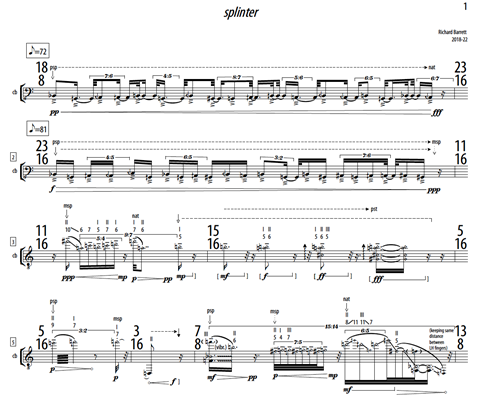| |
Volume 17, June 2023
Learning Strategies for Complex Rhythms: Approaching Richard Barrett's splinter for contrabass solo (2018-2022)
by Kathryn Schulmeister
5. splinter for contrabass solo (2018-2022) by Richard Barrett
splinter (2018-2022) for solo double bass is directly related to one of Barrett's in-progress works for large-scale ensemble titled PSYCHE12. The conglomerate work will feature several solo and chamber ensemble works that feature individual performers as well as small ensembles and provide short concert pieces that can be performed independently from the PSYCHE complete work. In the program notes for this work, Barrett writes: "splinter is derived from the solo part of elsewhen for contrabass and ensemble, which itself forms part of the conglomerate composition PSYCHE."13
Figure 3: Barrett: splinter (2018-2022) for contrabass solo, measures 1-7
At a first glance, the score for splinter (see figure 3)appears to be written in a language that I already know fluently and understand, a notation system which I have studied and practiced reading and interpreting for well over 20 years, with rigorous conservatory training at elite higher learning music institutions: standard Western music notation. Barrett's score, however, uses the Western music notation system to represent highly detailed layers of complex rhythmic information in such a way that challenges a performer in their ability to intellectually understand and technically execute the prescribed rhythmic material. Not only is the music not sight-readable in the sense that it is impossible to do a casual "read-through"14 of the piece (due to the rhythmic challenges), but it also requires a significant amount of creative deciphering, time, and attention to intellectually understand the notated material of each individual bar. Although it's quite normal to come across passages in contemporary music that require extensive practice to execute, it's another challenge altogether to have to solve the rhythmic problems of each individual bar just to simply conceive of how the rhythm might sound.
Although the pitch material of splinter similarly presents unique challenges to the performer, Barrett's score is remarkable in its successful conception of the physical parameters of the double bass and how the notes will fit within a player's hand position. Barrett even goes so far as to notate specific fingerings for passages that move about the full range instrument with rapid speed and varied durations. In this sense, given that Barrett's fingerings work well, he makes clear in his score that he has thoughtfully studied the instrument while writing exceptionally challenge music. His notated fingerings expedite the time-consuming process of forming personal fingerings for the work, a process which requires trial and error and potentially could require countless hours in addition to the numerous hours required to decipher the rhythmic material.
Aside from the gargantuan tasks of learning the rhythmic and pitch material of splinter, there are a select few moments of improvisational exploration that contribute to the form of the piece and provide a sense of poetic gesture to the seemingly ultra-rational score. At four distinct moments in the work, the scores indicates for the performer to explore gradual variations in timbre (see figure 4) in an unmetered duration (between 24-50") in a manner which Barrett describes as "...shouldn't be separated from the sounds around them, but should emerge as if taking place continuously below the music's audible surface."15 This instruction not only evokes a highly imaginative soundscape for the performer to draw upon in shaping their interpretation, but also suggests to the performer that the same exploratory spirit could be evoked in character from the metered material that makes up the majority of the work.
Figure 4: Barrett: splinter, measure 14
In several key moments of the work, Barrett composes a few passages for the bassist to perform three and/or four simultaneous musical lines across three and/or four strings, which approaches the brink of being technically impossible, however there are strategies for creating the effect of playing across the four strings. Barrett's score invites this sort of strategy in that it clearly notates parts of the lines that should be favored or played on certain strings, and exactly when to alternate the bow between different combinations of strings (see figure 5, measure 23). Although Barrett writes glissandi to be performed with the left hand, the alternating articulations of the right hand (the bow) will render the sound of the passage somewhat indeterminate and therefore gestural in form rather than strictly precise. The result is a unique timbral gesture that inhabits a musical space somewhere between the hyper precise single line notation that makes up most of the piece and the few unmetered open exploratory passages.
 Figure 5: Barrett: splinter, measures 22-24
Overall, then, I conceive of splinter as an 8-minute solo piece with five sections separated by unmeasured periods of timbral exploration. The first section (from measures 1-14) articulates a single melodic line, which frenetically inhabits a flexible rhythmic grid and expresses the pitch and dynamic range of the bass with rapid fluidity and agility, often with brief yet sizable glissandi. The second section (from measures 15-24) departs from the linear nature of the first section by articulating short gestures that chaotically alternate between different registers of the instrument. The second section also features moments where short gestures are rapidly performed by alternating strings within a close range of pitch, and introduces a variety of timbres, rhythmic, and gestural figures that contrast the singular nature of the first section (see figure 5). Although the second section also features glissandi, much more of the material in the second section is focused on the complex sonorities that emerge from the playing of multiple strings simultaneously and or back and forth in close succession. In the third section (measures 26-32), the texture of the work initially thins out to soft articulations of harmonics high in the double bass pitch range. In the middle of the third section, the score gives the performer an extensive opportunity to explore the triple stop of playing clustered pitches across the second, third, and fourth strings. The third section finishes with another flourish of high harmonics in fleeting glissandi gestures. The fourth section (measures 34-58) introduces two new types of material: fast slurred lines in stepwise motion or alternating thirds (with various quarter tones), and repeated alternations between multiphonics with slight variations and articulations of the open fourth string. As the fourth section progresses, the material becomes more varied and reminiscent of the prior sections save for the presence of single isolated articulations of varying textures including pizzicati16 and accented double stop harmonics17. The fifth and final section (measures 59-75) of splinter integrates multiphonics into a continuous stream of rapidly alternating notes which dramatically alter with varying intervallic relationships. The energy output required to perform this section suggests that measures 62-64 (see figure 6) are a climactic point of expression for the entire work. Measures 65 to the end could be interpreted as a coda, with brief references to gestures and material introduced earlier in the work, and a final continuously descending passage spanning the very last six measures of the work.
 Figure 6: Barrett splinter, measures 62-64
In the sections that follow, I will explain how I used multiple processes of rhythmic translation as a primary learning strategy for creating my performance interpretation of Barrett's splinter.
|
|




